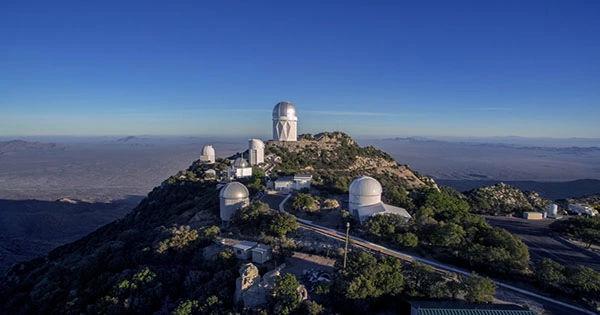The Contreras Wildfire swept across the southwest ridge of Kitt Peak, Arizona, on Friday, June 17, destroying four research telescopes at the National Observatory, which also houses NASA’s NOIRLab. The next day, the fire spread to other portions of the enormous observatory, engulfing telescopes and continuing to burn. The condition of the telescopes is mainly unclear, according to NOIRLab, since intensive firefighting continues today. “It is presently impossible to determine if any damage to the structures has occurred due to the continuous nature of the crisis.” NOIRLab (National Optical-Infrared Astronomy Research Laboratory) issued a statement saying, “We will notify any harm as quickly as feasible.”
Although it is unknown whether the flames have damaged the telescopes, the outsides of the buildings that house them appear to be relatively unscathed. Spot fires, on the other hand, continue to burn near some of the eastern structures, despite heavy firefighting operations. Four of the surrounding structures, which were employed as dorms and other support services rather than direct research, were demolished. “The road has been damaged, but it does not appear to be disastrous,” according to a NOIR update. “While we are not out of danger,” the Observatory stated, “the situation is improving.”
However, the fire might linger in the region for up to a week, and a shift in the wind could bring it back to the original location. Astronomers have praised the firefighters’ bravery and commitment. Kitt Peak was the United States’ first national observatory, and it has a permanent lease with the Tohono O’odham Nation, on whose property it was established with their approval, as long as it is utilized for study and teaching.
The Nicholas U. Mayall 4-meter Telescope and the WIYN 3.5-meter Telescope are among the big and medium-sized ground-based optical telescopes there. It also houses the University of Arizona millimeter-wavelength telescope and one of the Very Long Baseline Array dishes that are spread across North America. The SCU Lightning Complex fires just spared California’s Lick Observatory at Mount Wilson two years ago, and now Kitt Peak in Arizona is under threat. Kitt Peak, on the other hand, is very much an operational observatory, with both optical and radio telescopes playing a key part in recent discoveries. We have no idea how long this will last.
Because they must be built on the summits of mountains far away from city lights, major observatories have always been vulnerable to fire. Fire can rush up the hill and damage the observatory unless the mountain is above the timberline or is so volcanic that absolutely nothing grows there. A massive fire destroyed most of the structures at Mount Stromlo Observatory in 2003. The threat to the region’s numerous observatories has grown as a result of increasing temperatures and the megadrought in the southwest United States, so it’s not unexpected that two significant institutions have been damaged in less than two years. Instead, it’s most likely a foreshadowing of things to come.
















